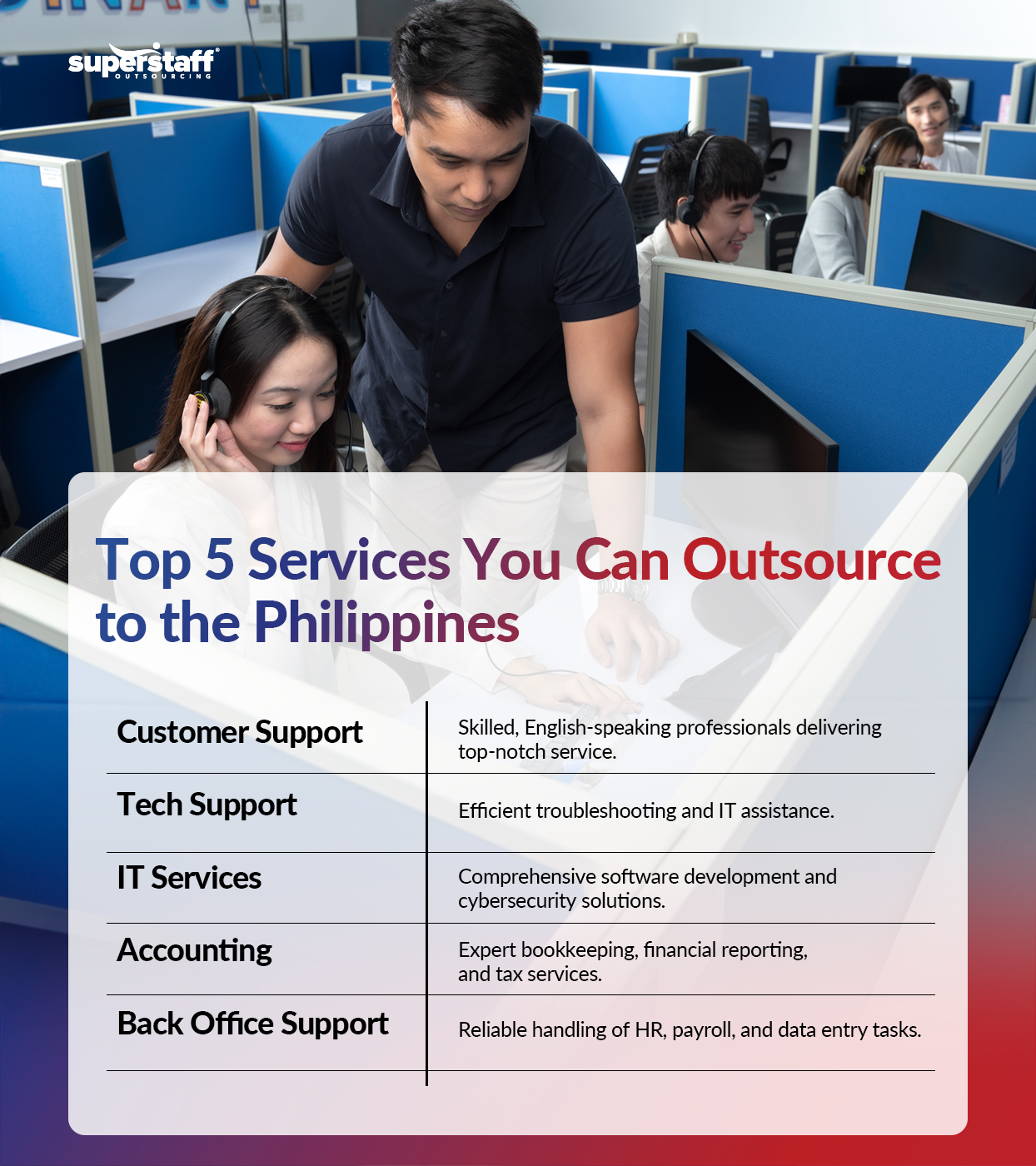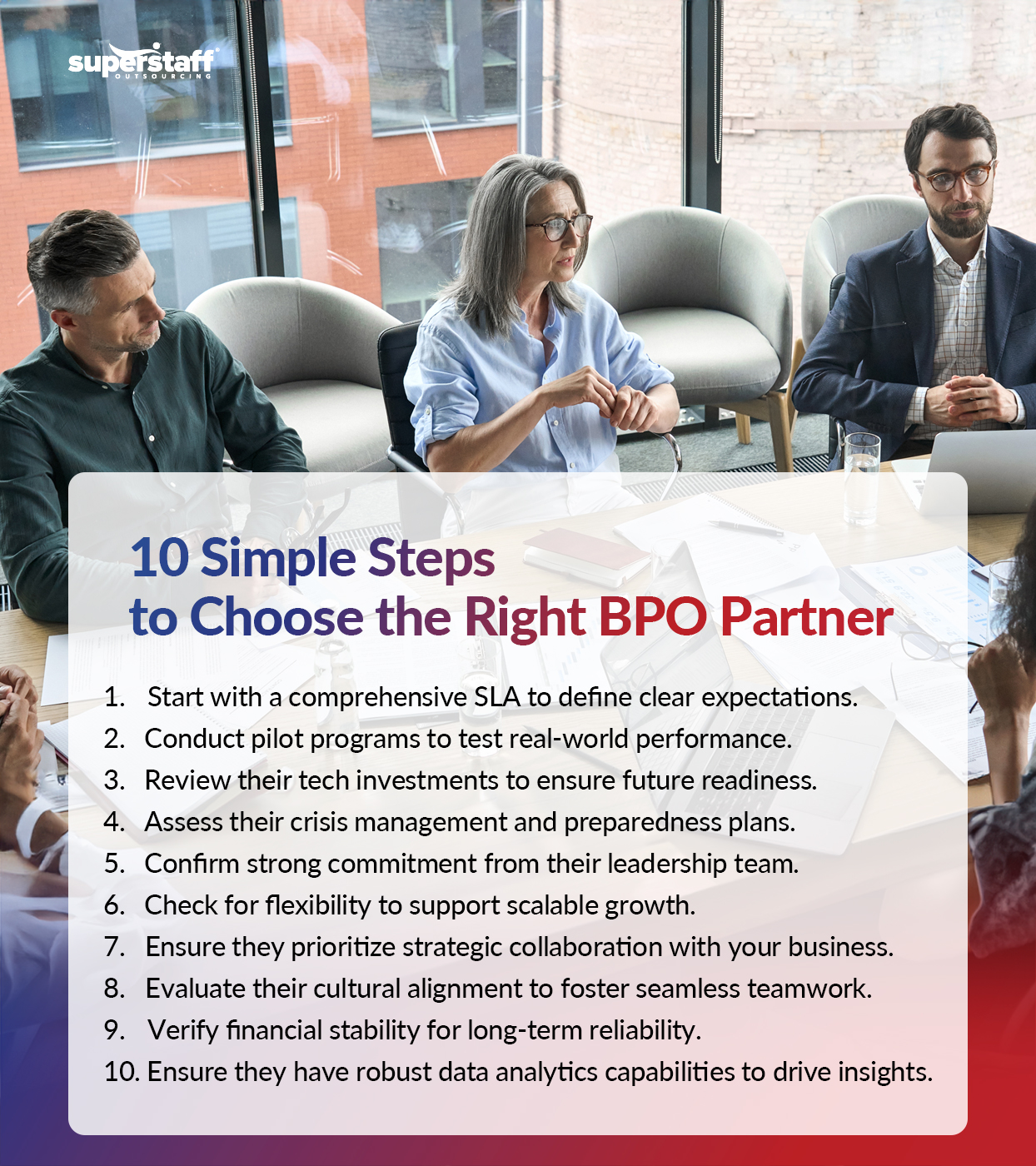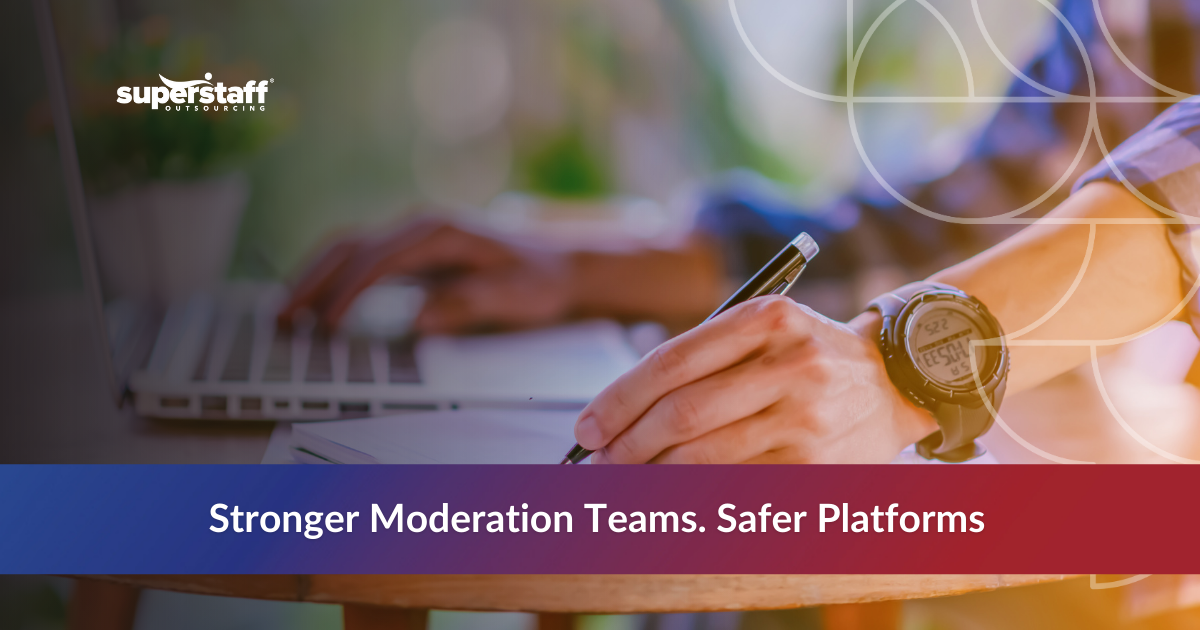
Outsourcing has become a cornerstone of staying competitive as businesses navigate expanding markets and ever-evolving customer expectations. For many, the key to scaling efficiently and meeting demands is finding the right BPO partner.
This decision is not just operational — it’s strategic. The right BPO provider will significantly impact your growth, agility, and ability to meet business objectives. Selecting a partner isn’t something to approach lightly. It requires careful evaluation, meticulous planning, and alignment with your long-term goals to ensure a successful collaboration.
This guide will explore essential factors you must prioritize when choosing the right BPO provider for your company. From understanding BPO fundamentals to outlining a strategic, step-by-step selection process, this resource will help you secure a partnership that fosters sustainable growth and drives measurable results.
What is a BPO partner?
Imagine your business is thriving, but growing demand pushes your in-house team to its limits. The pressure to maintain quality and meet expectations is mounting. What if there were a way to scale without overburdening your staff or losing focus on your core priorities?

This is where Business Process Outsourcing (BPO) becomes a game-changer. Outsourcing non-core tasks such as customer support, IT services, or accounting allows you to free up your internal resources to focus on strategic initiatives. BPO is an extension of your team, ready to handle the workload and drive efficiency—helping you scale faster without compromising service quality.
When it comes to outsourcing, the Philippines stands out as a premier destination. Known for its skilled, English-speaking workforce and strong customer service expertise, the country has earned a global reputation for delivering exceptional results. The Philippines combines affordability with deep cultural alignment and a strong understanding of Western business practices, making it an ideal partner for businesses seeking to streamline operations and reduce costs.
Whether outsourcing customer service, technical support, or back-office service solutions, BPO providers in the Philippines give you access to top-tier talent and a strategic edge in today’s competitive market. With the right partner, you can scale confidently and maintain the quality your customers expect.
10-Step Guide To Help You Choose a BPO in the Philippines

1. Scrutinize the SLA (Service Level Agreement).
More than just a contract, a Service Level Agreement (SLA) is a strategic tool that lays the foundation for a successful partnership. Think of it as the backbone of the relationship — a framework that sets crystal-clear expectations on both sides, breaking down what “success” looks like and, more importantly, how it will be measured.
It will guide all day-to-day interactions, ensuring that your business objectives are met with consistency and accountability. Start with laying out well-defined performance metrics that are both specific and measurable, directly linking to your broader business goals. These key performance indicators (KPIs) should be actionable, giving you and the provider a straightforward roadmap for what’s expected. Making these metrics transparent and time-bound creates an environment where progress is evident, measurable, and directly tied to outcomes you value. However, setting benchmarks for success is only part of the equation.
Including contingency plans within your SLA is equally wise to safeguard your operations and prepare for the unexpected. These plans outline precise steps if disruptions such as supply chain hiccups, unexpected demand surges, or outages occur. With a well-prepared contingency plan, you and your provider can stay agile, keeping operations seamless even when things don’t go as planned.
Additionally, specifying penalties and incentives for performance deviations can serve as both a safeguard and a motivator. If service quality drops, having penalties in place can help protect standards. On the flip side, incentives for overperformance give the provider extra motivation to exceed expectations, helping maintain a high bar for quality and responsiveness.
Once the SLA is crafted and agreed upon, testing the waters is next. A trial period with your provider can reveal whether they can deliver on the standards you’ve both laid out. This initial run provides valuable insights into their performance under real-world conditions, helping you confirm that the partnership is on the right track.
2. Conduct pilot programs and trials.
With your strategic framework in place, it’s time to take the next step: a pilot test. This real-world dry run will uncover hidden risks and fine-tune your approach, ensuring a smooth and successful transition before fully committing to full-scale outsourcing.
Running a pilot gives you a front-row seat to observe how effectively your chosen provider handles tasks, adapts to unexpected changes, and responds to real challenges — all within a controlled environment.
To get the most out of a pilot, set clear, measurable objectives and specific success criteria. This clarity will allow you to objectively assess the provider’s performance based on predefined benchmarks rather than subjective impressions. During the pilot, maintain open channels for detailed reporting and regular feedback sessions. These will help you pinpoint strengths and potential improvement areas, giving you a well-rounded picture of the provider’s capabilities. With these insights, you can refine your contract terms and expectations, ensuring everything is fully aligned and ready for smooth scaling.
While a pilot is a great way to evaluate immediate performance, it’s still just the beginning. The real test lies in whether the provider can stay agile and responsive as your business evolves. Once the pilot ends, one question remains: How can you ensure your partner will continue to adapt and deliver, no matter what changes come your way?
3. Assess their future-proofing and innovation capabilities.
According to Deloitte’s 2023 Global Technology Leadership Study, tech budgets have been rising, with businesses spending 5.49% of their revenue on tech in 2022 — a steep jump from only 4.25% in 2020. This trend is projected to continue and reach 5.85% by 2024. The numbers show that tech is an indispensable tool in today’s digital era. However, a future-ready outsourcing provider should be more than just technically competent.
Research and development (R&D) is just as important. Global R&D spending hit $2.48 trillion in 2022 — and U.S. giants like Amazon led with over $70 billion invested that year. Looking closer at your provider’s R&D efforts will give you a sense of their commitment to staying current and their ability to bring fresh ideas and tools to the table.
Another factor to consider is their automation and artificial intelligence (AI) initiatives. Providers that leverage cutting-edge automation and AI tools often offer greater efficiency, streamlined operations, and faster problem-solving capabilities.
Consider this statistic: 42% of large enterprises (1,000+ employees) are already running AI initiatives, and 40% are actively exploring it. The momentum is growing, with 59% of these companies ramping up their AI investments. Partnering with a provider fully embracing these advancements can mean the difference between average service and cutting-edge solutions that drive the best results.
It’s not enough for a provider to adopt these cutting-edge tools — you need a partner with a proven track record of investing in innovation that genuinely benefits clients. Dig into their history: Have their past investments delivered real customer value? A provider who consistently drives success through forward-thinking practices will likely bring that same commitment to your partnership.
Don’t stop there. Look for a provider who can see around the corner, actively monitors industry trends, and adjusts to market changes. A partner with this agility and foresight is ready to support your long-term goals, no matter how the business landscape evolves.
While innovation is a powerful asset, it’s just one part of the equation. Stability in times of crisis is equally essential, as it ensures they can weather challenges and maintain reliable service through any situation.
4. Ensure they have robust crisis management and business continuity plans in place.
Disruptions are an increasing reality in business today. Global supply chains faced over 11,600 disruptions in 2021 alone, with North America seeing the highest share of these events. These challenges, whether natural disasters, global pandemics, or cybersecurity breaches, can strike anytime.
With a solid crisis response plan, you can keep things running smoothly, no matter what comes your way. A strong plan minimizes risk, protects your core processes, and ensures your business stays resilient — even when the unexpected hits. But how can you ensure your provider is equipped to handle when things go south?
Start by investigating their disaster recovery protocols. Look at how quickly they can bounce back from disruptions, restore critical operations, and protect sensitive data during an emergency. Look for documented case studies of their real-world crisis responses — these can offer a clear picture of their track record and show how they handle the unexpected.
Verifying that the provider has robust insurance and meets regulatory standards is essential, ensuring both sides are protected from extra risks. While readiness is critical, executive leadership’s commitment often determines whether a plan is merely good on paper or can transform into swift, effective action when needed most.
5. Secure the engagement and commitment of their C-Suite
Outsourcing is more than just a service — it’s a true partnership. As executives, it’s only natural that you’d want to stay connected with your partner’s C-suite. It’s a show of good faith on their part.
When your provider’s leadership team is directly involved, it sends a strong message of shared direction and responsibility. This lays the groundwork for a partnership rooted in transparency, adaptability, and a proactive approach to shared goals. With their C-suite team invested in your partnership, their company becomes better equipped to respond to your evolving needs, adjusting and aligning as your business grows.
To achieve this, you must establish regular strategy meetings with their senior leaders. These sessions allow both sides to review progress, refine long-term goals, and address challenges head-on, building a unified commitment to success. Take the time to evaluate the provider’s dedication to high-level accountability and strategic decision-making. A partner whose leadership prioritizes agility and responsiveness will bring adaptability and resilience to your partnership, making timely adjustments to keep pace with your changing landscape.
When both teams are aligned around a unified vision, the foundation for a strong, flexible, and future-ready partnership is in place — one prepared to tackle any challenge that comes your way.
6. Evaluate scaling agility and contract flexibility.
As your business needs evolve, so too should your outsourcing relationship.
What you need from a provider today might differ from what you’ll need a year or two, and a strategic outsourcing relationship is flexible enough to stay in sync with market shifts and meet your changing needs. When providers can quickly adjust to new demands, they make you more resilient and keep you primed to capture opportunities as they come.
Evaluate their track record in scaling efficiently. Providers who can rapidly expand their operations without sacrificing quality show they’re equipped to handle increased demands smoothly. It’s also essential to review contract terms around SLAs and pricing adjustments. Built-in flexibility saves you from the delays and complications that often arise when change is needed. The ideal provider will offer scalable options without burying you in red tape — agility should feel seamless, not bogged down by bureaucracy.
While flexibility is essential, a collaborative approach that sparks innovation and drives continuous growth distinguishes top providers. This strategic mindset turns the relationship into a partnership that can navigate change and stay focused on long-term success.
7. Ensure their role in strategic co-creation and advisory.
Your BPO partner is your partner for a reason. You don’t want someone following your directions unquestioningly without thinking critically or contributing to the bigger picture.
The best BPO relationships go beyond simple task execution. They involve collaboration, innovation, and shared accountability. A provider acting as an order-taker limits the potential for growth and strategic alignment. Instead, you need a partner who understands your business inside and out and can challenge the status quo, offer fresh perspectives, and provide valuable insights that help shape your strategy.
A strategic partnership means inviting them into high-level strategy conversations where their industry expertise can offer valuable insights. Rather than just executing tasks, a strong partner actively contributes ideas and recommendations based on their vast experience across different sectors. They’re uniquely positioned to spot emerging trends, identify efficiencies, and suggest solutions you might not have considered. The most effective providers share their knowledge and are willing to adapt their approach based on these insights, ensuring their solutions evolve with your business.
The key to this collaboration is an ongoing, open dialogue. The best providers take the time to understand your needs, continuously refining their strategies to stay aligned with your objectives. This builds agility, enabling your business and partner to adjust strategy as market conditions change swiftly or your business scales.
But this isn’t just about tactical flexibility — it’s about cultural alignment, too.
When your BPO provider shares your values and understands your brand, they become an extension of your team, working seamlessly to help you overcome challenges and capitalize on new opportunities. This mutual understanding, built on trust and shared commitment, transforms the partnership into a dynamic force for growth, innovation, and long-term success.
8. Cultural Integration and Employee Engagement Programs
Imagine this: Your business is facing an ambitious growth target, and you’ve partnered with a BPO provider to help meet those goals. However, as the weeks pass, you notice a disconnect between your team and theirs. Communication feels strained, and collaborative efforts often fall short, causing delays and inefficiencies. This scenario is a reality for most businesses, with nearly two-thirds (64%) reporting that poor collaboration costs them at least three hours of productivity each week. This disconnect can quickly derail even the most well-laid plans and hinder progress.
The key to avoiding such setbacks lies in aligning workplace cultures. A company’s workplace culture is at the heart of its operations, shaping everything from employee engagement to decision-making processes. When your BPO provider shares your company’s values and culture, collaboration flows seamlessly, boosting productivity and driving success. A provider who understands your vision and ways of working becomes a true partner — one who doesn’t just execute tasks but actively contributes to your strategic goals. By including them in high-level discussions and leveraging their industry experience, you unlock fresh ideas and innovative solutions that accelerate growth.
When selecting a BPO provider, aligning their culture with yours is as important as the quality of their services. A partner that understands and embraces your company’s core values will seamlessly integrate with your team, fostering a collaborative environment that drives productivity and innovation. This cultural synergy lays the foundation for a partnership that meets day-to-day operational needs and supports long-term strategic goals.
Seek providers willing to adapt to your business and bring recommendations based on their broad experience. This adaptability and proactive collaboration transform the provider from a vendor into a strategic ally. When culture and values align, both teams are empowered to work together toward shared success, ensuring a strong, thriving partnership that can evolve as your business scales and adapts to new challenges.
9. Assess their financial health and stability.
Nobody wants to jump on a sinking ship. When your business depends on another company to support its operations, any cracks in their foundation can quickly become significant disruptions. That’s why it’s so essential to thoroughly assess your BPO partner’s financial health before diving in.
Ensuring your provider is financially stable and capable of weathering business ups and downs is critical for a lasting, successful relationship. A BPO provider with a solid financial foundation isn’t just about maintaining day-to-day operations. It’s the key to securing a partnership that can grow, adapt, and tackle opportunities and challenges without disruption. Financial stability becomes the bedrock of a reliable, long-term collaboration, giving you the peace of mind that your provider can support your business through any storm.
Review the provider’s financial statements and credit ratings to assess this stability. This will give you a clear picture of their revenue streams, profitability, and overall economic health, helping you gauge their readiness for future demands. Don’t overlook past financial challenges either — how a provider has navigated difficult times can reveal their resilience and approach to crisis management.
Additionally, consider potential risks affecting their financial outlook, such as market shifts or industry-specific pressures. Understanding these factors empowers you to take proactive steps to protect your own business from disruptions. When combined with the ability to leverage data insights, a solid financial foundation can drive operational efficiency, innovation, and sustained growth for both parties, ensuring your partnership thrives in the long run.
10. Evaluate their ability to harness data-driven insights and analytics.
Businesses that know how to harness the power of data stay ahead of the competition. In 2022, an impressive 87.8% of companies ramped up their data investments, recognizing the immense potential for growth, efficiency, and innovation of strategic data usage.
When considering a Business Process Outsourcing (BPO) provider, their ability to leverage data and analytics can be a game-changer for your business. A provider skilled in data-driven insights doesn’t just improve processes—they offer strategic guidance that can accelerate your organization’s growth and sharpen its competitive edge.
Start by looking at how your potential provider handles data: Do they have a robust infrastructure to collect and analyze large, complex data sets? Do they integrate analytics into their service delivery to proactively recommend improvements? The right provider will interpret data and use it to optimize operations, enhance customer satisfaction, and give you actionable insights that help you make informed decisions. By tapping into their expertise in analytics, you can unlock a wealth of opportunities that add measurable value to your business, setting the stage for long-term success.
Choosing the Right BPO Provider for Your Company: Key Steps to Ensure a Strategic Partnership
The saying “You are only as strong as your weakest link” holds true in today’s competitive business environment. When outsourcing, the partner you choose can determine the success or failure of your efforts. Every step of the evaluation process plays a critical role in establishing a partnership that drives your business forward.
To secure a successful collaboration, focus on evaluating Service Level Agreements (SLAs), conducting pilot programs, assessing innovation capabilities, reviewing crisis readiness, fostering executive alignment, and ensuring strategic fit. These steps address immediate needs and position your business for long-term growth.
The time to act is now—but rushing this decision could lead to costly missteps. Take a comprehensive approach and choose a trusted BPO partner in the Philippines, like SuperStaff. With proven expertise and a commitment to excellence, they can strengthen your operations and prepare your business to meet future challenges and seize opportunities.






